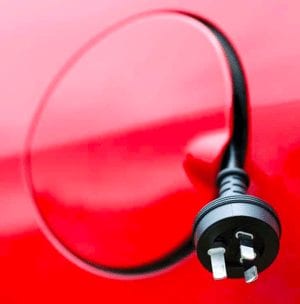It’s not exactly rocket science. In an electricity market where demand is shrinking and renewable energy technology is shooting down the cost curve, growth in electric vehicle uptake could provide a much needed stimulus for struggling utilities.
In Australia, electricity demand has fallen, and utilities are struggling, but electric vehicle ownership is yet to take off. So why aren’t the nation’s gentailers doing all they can to promote the uptake of EVs?
It’s a question Mark Higgins – founder and senior director of US company Strategen Consultants and the California Energy Storage Alliance – struggled to answer, when asked by an audience member at this week’s All Energy Australia conference in Melbourne.
And it doesn’t make much sense, especially when you consider the potential benefits for utilities; not just of all the added gigawatts of demand, but of all that distributed battery capacity becoming available to the grid.
According to Higgins, most EVs are only driving about 4 per cent of the time, and charging 10 per cent of the time. For the remaining 86 per cent, they are effectively untapped energy storage on wheels.
With managed charging and the right tariff mechanisms and incentives, this could be used to smooth electricity demand, manage spikes and shift loads, eliminate back-feeding and reduce the need for costly network upgrades, said Higgins.
In Australia, this would benefit consumers too, he said, considering that $51 of every $100 spent on electricity bills were for expenses related to poles and wires.
But for utilities, there is also a major downside of failing to move on this opportunity, that could be the final nail in the coffin for utilities from the old energy order.
“Grid defection will happen, sooner than many think,” Higgins told the conference on Wednedsay. “Especially in Australia,” he added, where a combination of high electricity prices and increasingly competitive self-generating solutions will pave the way.
“Customers should be rewarded for aligning their energy use and storage with the grid’s needs,” Higgins said. “Inflexible penalties for distributed generation will force people off-grid – and soon.”
As we reported back in July, Australians are now installing solar at a rate of more than 15,000 households a month – less than half the capacity when feed-in tariffs were at their peak, but much more than most independent experts had predicted. In June 2014, that translated into added peak capacity of 64.8MW, with the total in the first half of 2014 being 92,045 households and 389MW of rooftop solar.
Add EV batteries to the equation, and you have a problem – for centralised energy generators and retailers, anyway. Households are already onto the fact that energy storage and solar PV are a perfect match. But what if people could use their electric vehicles to store their excess solar generation through the day, for use at night.
Well actually, they already can. As far back as 2011, Nissan unveiled a system that enables electricity stored in its LEAF lithium-ion batteries to be used in the household; effectively acting as home battery backup system with enough storage to run the average Australian household for over a day.
The batteries being used in some of the latest model Teslas can store enough energy to power the average house for three and a half days.
And with the rate of innovation of smart technology, and of household self-generation and consumption systems, as well as the decreasing cost and increasing efficiency of batteries, the use of EV batteries as household self storage mechanisms could provide the last piece of the off-grid puzzle.
In the US, where EV uptake is on a much steeper curve than in Australia – in California alone, there are now upwards of 100,000 EVs on the road and the state’s goal is for 1.5 million by 2020 – this is more of a realistic threat. And some in the energy industry are onto it.
In August this year, the Edison Electric Institute, the US power industry’s main trade group, called on utilities to better promote electric cars to stimulate demand for electricity and help reverse trends that threatened the long-term viability of some in the industry.
In a report, the organisation called electric vehicles a “quadruple win” for power companies looking to boost demand, find new ways to interact with customers, support environmental goals and mandates, and reduce operating costs through electrifying their own fleets.
But to Higgins – who previously served as Pacific Gas and Electric Company’s lead on electric transmission policy work at the California Independent System Operator and FERC – perhaps the biggest motivation for utilities to encourage growth in electric vehicles is to avoid the kind of outcome seen in Hawaii, which has been described as being “at the bleeding edge” of the global energy transformation.
In Hawaii, investor-owned utilities fell hopelessly behind the solar curve as the islands’ households rushed to install it to combat the highest electricity prices in the US. After trying to put the breaks on the installation of rooftop PV, the utilities were more or less ordered to lift their game on grid-connected distributed generation by Hawaii energy regulator.
Backed by the state’s governor, Neil Abercrombie, the PUC put forward a plan to remedy this situation, giving HECO 120 days to either adopt this plan, or come up with a better idea.
“Hawaii has already entered a new paradigm where the best path to lower electricity costs includes an aggressive pursuit of new clean energy sources. […] Utilities need to move with urgency to modernize the generation system on each island grid, as delays are lost savings opportunities,” wrote the PUC.
“This is not the future we want,” Higgins said, bringing the focus back to Australia.
“Good policies will change the dynamic,” he said. “Reward consumers for doing the right thing.”








